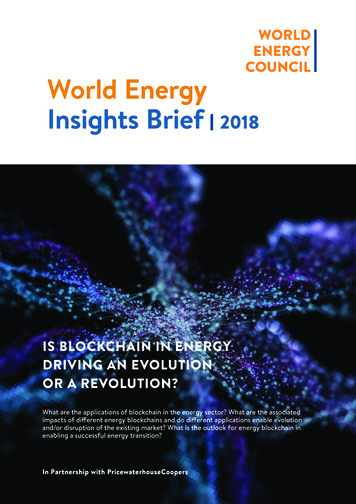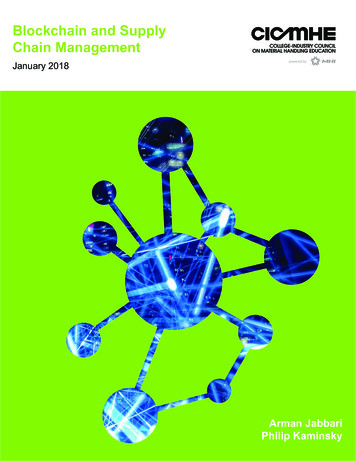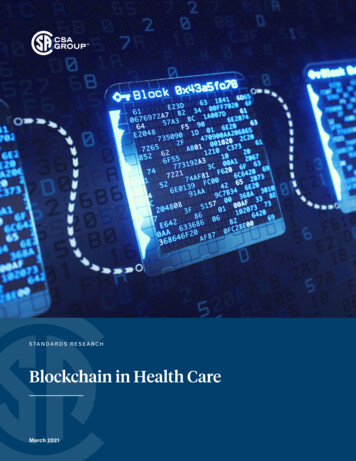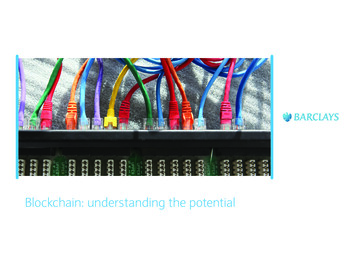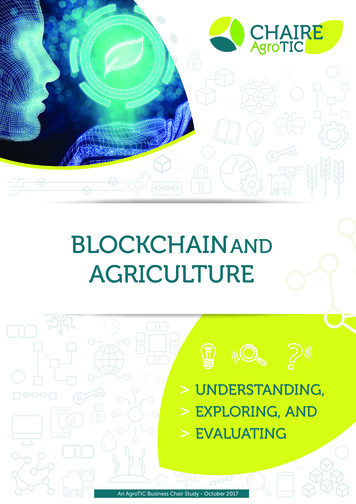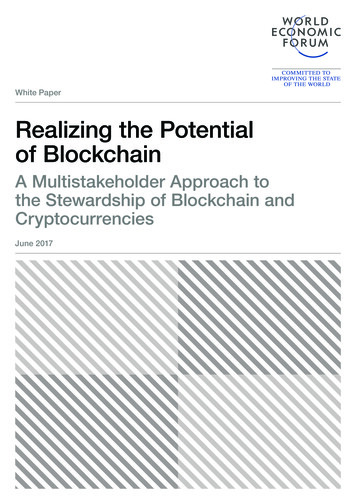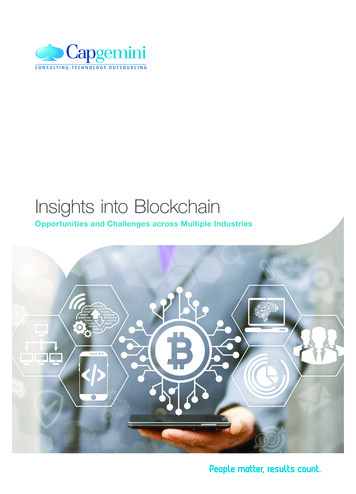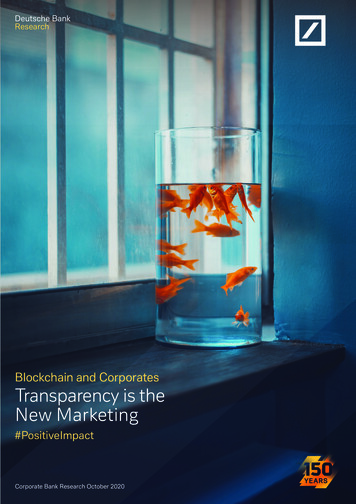
Transcription
Deutsche BankResearchBlockchain and CorporatesTransparency is theNew Marketing#PositiveImpactCorporate Bank Research October 2020
Trust is like the air we breathe—when it’s present, nobodyreally notices. When it’s absent, everyone notices.Warren Buffett
AbstractLike the Internet in the 1990s, distributed ledger technology (DLT) and blockchain are set totransform the economy. Yet, two-thirds of senior executives still don’t know what DLT is, and thosewho do tend to ignore its uses outside of some simple financial applications.While 90 percent of key advanced-country banks are experimenting with or investing in thetechnology, the non-financial blockchain uses also have enormous potential, in part becauseblockchain can be used by a wide array of businesses. Indeed, blockchain will provide new ways ofmanaging information, open opportunities for businesses to build trust with customers, and helporganisations improve transparency and become more decentralised. In fact, blockchain could leadto a revolution in corporate structure.For this report, we interviewed senior executives of major consumer goods businesses, emergingstart-ups, and new blockchain companies. We explain how DLTs are being used, and how the publicand private sectors can overcome knowledge gaps and other challenges related to DLTs. We includea case study about Nestlé to show how the company is using blockchain to share local sourcinginformation. The final section offers recommendations for how corporations should implement DLTs.While customer “trust” can be a subjective topic, the data show that less than a quarter of Americanstrust big companies. By comparison, over two-thirds trust small companies. Consumers, particularlyyounger demographics, increasingly value authenticity, local roots, quality, and customisedproducts. These consumer trends frequently exist in tension with the massive and obscure supplychains used by large corporations. Here, DLTs will help. We show in the report how DLTs can enablelarge corporations to improve relations with consumers. This is particularly the case for industrial,packaged goods, consumer electronics, and retail corporations.Corporate supply chains can most benefit from DLTs. Globally, some companies have already startedusing blockchain in their supply chains. These include Airbus, Carrefour, De Beers, Ford, Nestlé,SAP, Subway, Tyson, Unilever, and Walmart. Merck, a major pharmaceutical company, is also pilotinga blockchain project. In a time when a Covid-19 vaccine could be released soon, the demand willquickly outweigh the supply. That unfortunate situation could tempt nefarious agents to fabricatecounterfeit vaccines. Knowing that, legitimate pharmaceutical companies could use a DLT to tracktheir vaccines so as to avoid counterfeit products. In the same way, companies that implement DLTscan increase transparency about their products and supply chains, and improve quality controlwhich, in turn, builds trust with consumers.Deutsche Bank Research / Blockchain and Corporates: Transparency is the New Marketing3
Summary on a PageConsumer Behaviour Consumers increasingly value authenticity, local roots, higher quality, and customised products.These consumer desires exist in tension with the massive and obscure supply chains used by largecorporations. In a survey, 94 percent of customers said it is important for brands and manufacturers to betransparent about what is in their food and how it is made. Furthermore, 37 percent of consumers say they will switch to companies that provide more detailedproduct information, and those people are nearly twice as likely to access this information throughdigital labels. Consumers are open to using digital channels (digital labels, free mobile apps, QR codes) to find theinformation they need—this is key for corporate distributed ledger technology (DLT) adoption.Company Adoption Large corporations still struggle to establish trust with consumers, in part because consumersdo not perceive them to be transparent. Product development, manufacturing, supply chains,and distribution practices typically remain hidden from consumers. Corporates can use DLTs,and specifically blockchain, to connect with customers and help large organisations increasetransparency and improve the quality control of their products. As a result, large corporates canbegin to bridge the “trust deficit” they have with customers, and reduce the risk of product failuresand scandals. Globally, many companies are already using blockchain in their supply chains. These include Airbus,Carrefour, De Beers, Ford, Nestlé, SAP, Subway, Tyson, Unilever, and Walmart. The three main properties of DLT—transparency, immutability, decentralisation—make it anideal tool for improving process efficiencies across the supply chain. Blockchain enables B2Bagreements between parties by using digital smart contracts. This increases transparency in thesystem, improves the speed of payment processing, and reduces intermediary expenses. Anyrecord—purchases, warranties, ownership status, etc.—can be safely verified and transferred on ablockchain network, thus improving supply chain transparency. The benefits of using blockchain for decentralised supply chain management are manifold: (a)a transparent ledger system that can trace every product movement; (b) real-time tracking andquality control of any material within the system; (c) faster transactions; (d) improved trust amongmanufacturers and vendors via use of smart contracts; (e) product certifications that ensureeverything is certified on the blockchain, eliminating human error and fraudulent activities; (f)greater security as immutability ensures protection and improves accuracy; and (g) reduced costs asit removes middlemen, offers greater accuracy, and eliminates counterfeit products. For a successful implementation, corporates must: (a) target the right business problem; (b) includeusers in the design stage; (c) pilot before scaling up; (d) carefully consider the design of DLTs. Tracingthe whole supply chain requires the collaboration of suppliers, producers, distributors, and retailers.AuthorsMarion Laboure, Ph.D. marion.laboure@db.comJim Reid jim.reid@db.comDeutsche Bank Research / Blockchain and Corporates: Transparency is the New Marketing4
Introduction: The Devastating Impactof Distrust on CorporationsLike the Internet in the 1990s, distributed ledger technology (DLT) and blockchain1 are set to transformthe economy. The technology provides new ways of managing information, rebuilding trust, and helpingorganisations become more transparent. This could lead to the decentralisation of corporate structure inthe public and private sectors.Today, 90 percent of large European, North American, and Australian banks are experimenting withor investing in DLT and blockchain solutions to solve many problems. Yet, blockchain and other DLTsare typically discussed only in the context of digital currencies, such as bitcoin.This report explains how DLTs can help large corporations improve relations with consumers. This isparticularly the case for industrial, packaged goods, consumer electronics, and retail corporations.Corporate supply chains can most benefit from DLTs. Globally, some companies have already started usingblockchain in their supply chains. These include Airbus, Carrefour, De Beers, Ford, Nestlé, SAP, Subway,Tyson, Unilever, and Walmart. Merck, a major pharmaceutical company, is also piloting a blockchainproject. In a time when a Covid-19 vaccine could be released soon, the demand will quickly outweigh thesupply. That unfortunate situation could tempt nefarious agents to fabricate counterfeit vaccines. Knowingthat, legitimate pharmaceutical companies could use a DLT to track their vaccines so as to avoid counterfeitproducts. In the same way, companies that implement DLTs can increase transparency about their productsand supply chains, and improve quality control which, in turn, builds trust with consumers.For this report, we interviewed senior executives of major consumer goods businesses, emergingstart-ups, and new blockchain companies. We explain how DLT is being used, and how the publicand private sectors can overcome knowledge gaps and other challenges related to DLTs. The finalsection outlines recommendations for how corporations should prepare to implement DLT.All successful businesses rely on consumer trust. However, larger corporations have lower rates ofconsumer trust—in part because they lack transparency. This lack of transparency often becomes acritical problem when a company faces a major product failure or, worse, a scandal.A key problem for large companies is that product development, manufacturing, supply chains, anddistribution practices typically remain hidden from consumers. DLTs, and specifically blockchain, can helplarge organisations increase transparency and improve the quality control of their products. Customerscan use smartphones to interact more with companies and thereby help the company build trust.There is a long precedent of corporate scandals and product failures. Just a few include the spreadof mad cow disease in the 1980s and 1990s, fire-prone cellphones, counterfeit goods, the horsemeatrevelation of 2013, and more recently, falsified car emissions technology. These types of scandals causewidespread distrust among consumers. They change public opinion and buying habits. News spreadsvirally through social networks causing considerable damage to company stock prices whether a firm isguilty or not. Over the long term, scandals and product failures tarnish company reputations, hinder thecapacity to launch new products, and suppress the ability to regain market traction.Scandals can have particularly acute effects for food manufacturers. Inner Mongolia Yili Industrial Group Co.was one of the twenty-two Chinese firms implicated in the 2008 scandal involving milk, infant formula, and otherfood products that had been adulterated with melamine. It took more than a year for the company to recover thesame share price that it had before the scandal. Likewise, in 2013, the reputation of the British UK retailer Tescowas significantly tarnished due to the European horse meat scandal. The scandal had a discernible, long-termimpact on the company. In December 2013, the US retail giant Target reported that hackers stole data from upto forty million shoppers. Share price volatility was limited, but it took nearly a year for the company to recover.1 In this report, the terms ‘blockchain technology’ and ‘distributed ledger technology’ are commonly used interchangeably. For more details, please see‘Decrypting Blockchain and DLTs: A Revolution in Data Management’ p8.Deutsche Bank Research / Blockchain and Corporates: Transparency is the New Marketing5
Another example of how a scandals can decrease customer trust is the Deepwater Horizon oil spill in 2010.Considered to be the largest marine oil spill in history, it has taken years for BP to recover from the episode.In share price terms, it took over six years for BP’s total return to rise back above its pre-spill level.Share price of companies impacted by “trust scandals”Inner Mongolia YiliTargetBPTesco220200index 100 when the scandal busts180160140120100806040daysc ofan tht da e1 lmont th2mont th3mont th4mont th5mont th6mont th7mont th8mont th9mot nt10hmont th11mot nt12hmot nt13hmont th14mot nt15hmont th16mont th17mot nt18hmont th19mot nt20hmot nt21hmont th22mot nt23hmot nt24hmonth20Source: Bloomberg Finance LP.As mentioned, consumers tend to distrust large corporations more than small businesses. Thisis true regardless of geographic location and regardless of product category (food, beverages,cosmetics, cleaning products, etc.). Three decades of research show that consumer confidence insmall companies has constantly ranked higher than large companies. In 2019, only 23 percent ofAmericans trusted big companies, while 68 percent trusted small companies.How Americans trust small and big businessesBig businessSmall e: Gallup. Note: percentage of citizens who have a great deal/quite a lot of confidence in large vs. small businesses.Deutsche Bank Research / Blockchain and Corporates: Transparency is the New Marketing6
Small-cap performance relative to the S&P 500 (index, 1995 100)S&P LargeCap 500S&P SmallCap 6001000900800700 64%The divergence hasaccelerated since urce: Standard & Poor’s, Haver Analytics.In addition, over the last decade, consumer perceptions (among other things) have impacted buyinghabits, which has a bottom-line impact on revenues and profits. Small-cap stocks have outperformedlarge-cap stocks at both the composite and industry levels, and the market share of the largercorporations in the US has tended to decrease.2Small companies benefit from brand likeability. Consumers perceive them as being local, honest,trustworthy, decent, sustainable, ethical, and healthy. This trend is even more pronounced withmillennials who are not committed to big brands, but to authentic companies and products.Large corporations still struggle to establish trust with consumers, in part because consumers don’tperceive them to be transparent. That transparency extends to several facets of corporate behaviourbut, in recent years, there has been a growing awareness and focus on transparency in corporatesupply chains.DLTs, and specifically blockchain, can help large organisations increase transparency and improve the qualitycontrol of their products, thereby building trust while reducing the risk of product failures and scandals.To better understand how blockchain and other DLTs can provide solutions to large corporations, wefirst need to have a basic understanding of how these technologies work.2 It does not imply total causation, but certainly has contributed to the outperformance of small companies.Deutsche Bank Research / Blockchain and Corporates: Transparency is the New Marketing7
Decrypting Blockchain and DLTs:A Revolution in Data ManagementDistributed Ledger Technology: A Shared DatabaseWe can compare DLTs to a collaborative document creation tool, such as Google Docs. In the past,transactions were saved on a centralised database, such as a computer drive. If someone hacked thedrive, he or she could steal or alter the information contained therein. Similarly, somebody would haveto hold the “master” file and ensure that data within it were always up to date.With DLTs, many parties can collaborate on a single document. All changes are recorded for all collaboratorsto see, which theoretically improves security because the information is dispersed rather than centralised.DLTs promise a more transparent, accountable, efficient, and secure way of exchanging decentralisedstores of information that are independently dated, automatically replicated, and immutable. The keycomponents of DLT include shared recordkeeping, multiparty consumers, independent validations,tamper evidence, and tamper validation. DLTs bring most of the improvements to the back-endprocesses and data management rather than impacting end-user experiences.DLTs can be “permissioned”—only those with prior authority can make modifications—or “permissionless,”meaning that anyone can make changes or additions. Some DLTs are public—fully and publicly viewableand having hundreds or thousands of nodes. The most famous example of a public DLT is the bitcoinblockchain. They can also be private—available only to certain entities. These DLTs might only have afew nodes. They may also be a combination of public and private. Most commercial DLTs will use private,permissioned architecture to optimise network openness and scalability.Architecture based on permission and ownershipArchitecture based on read, write, or commitpermissions granted to the participantsAccess to ledgeris open to publicAccess to ledgeris restrictedPUBLICPRIVATEArchitecture based on ownershipof the data structurePERMISSIONLESSAnyone may join, anyone mayvalidate a transaction Anyone can join, read, write, andcommit Hosted on public servers Anonymous, highly resilientPERMISSIONEDParticipants may perform specific rolessubject to permissions Anyone can join and read Only authorised and knowparticipants can write and commitExample: rippleExample: bitcoin, ethereumLow scalabilityMedium scalability Only authorised participants canjoin, read, and write Hosted on private servers Only authorised participants canjoin and read Only the network operator can writeand commitExample: Hyperledger Fabric,Enterprise Ethereum AlliancesHigh scalabilityVery high scalabilitySource: McKinsey & Company and Deutsche Bank.The power of DLTs, as described above, is their ability to help large corporations build trust with consumers.Deutsche Bank Research / Blockchain and Corporates: Transparency is the New Marketing8
Blockchain: Keeping Chronological Track of DataThe term blockchain is widely known and commonly used to define the whole family of DLTs in thepublic sphere. However, blockchain has features that make it distinct. It is a chain of cryptographicallylinked data blocks that efficiently and securely time-stamp digital data in distributed systems.Blockchain consists of a list of records called blocks. These blocks are securely connected usingcryptography. Each record has a unique timestamp and transaction date. Blockchain data is difficult tomodify because changing one block disrupts all subsequent, connected blocks. Thus, change requirespermission from the overall network.Creating a blockchain transactionStep 1Step 2Step 3Step 4When two partiesinitiate a transaction,blockchain assigns anencryptionBlockchain verifiesthe transaction andcreates a blockThe new block isappended to theblockchainThe blockchaintransaction is nowcomplete and theledger is updatedThe primary difference between blockchain and other forms of DLTs is related to data storage.Blockchain data is stored in groups, or blocks, of information. It is impossible to delete or modifyinformation previously stored on the chain because blocks are replicated across multiple ledgers.Blockchain uses a set of shared, secure, and distributed, and independently validated records. Bycontrast, other distributed ledgers don’t employ a chain of blocks.The security and efficiency of blockchain makes it an ideal technology for business operations, supplychain systems, and so on. It can register information changes over time, which could be extremelyuseful for tracking, say, an agricultural product’s journey from farm to fork. Thus, it offers the potentialto increase transparency and trust among consumers.Deutsche Bank Research / Blockchain and Corporates: Transparency is the New Marketing9
Blockchain Can IncreaseTransparency and TrustGlobal sourcing and outsourcing increase the length and complexity of the supply chain. Consumerbrands end up aggregating subcomponents (e.g. a screen or a processor) which are themselves anaggregation of subparts (e.g. transistors) from multiple parts of the world. This creates several risks—counterfeiting, procurement, inventory management—and adds complexity and costs.According to the World Health Organization, over 50% of medicines purchased on illegal websitesare counterfeit.3 The example of pharmaceutical supply chain (below) is sufficient to highlight thecomplexity. They comprise not only manufacturing the vaccine, but also storage and packagingcomponents, cold-chain transit, domestic and global shipping. The distribution involves many playersfrom pharmacies to hospital to insurance companies to distributors.Pharmaceutical Supply ChainDrugManufacturerPayers(Gov’t / Employers/ Insurers)Wholesalers macyBenefit Manager(PBM)Specialty / Retail Other SitesPharmacyRebatesPatientsReimbursementProduct DistributionSource: Deutsche Bank adapted from Janssen Global Services, LLC, 2018 Janssen U.S. Transparency Report (Janssen, Mar. 2019), 21.Meanwhile, on the consumer side, there is a high demand for local, authentic, quality, and customisedproducts. These consumer desires exist in tension with the massive and obscure supply chains used bylarge corporations. So, large companies like Carrefour seek to be nimbler with product design and supplychains, and to be more transparent about product quality and origin. But it is very difficult to capture thenecessary information and present it to customers in a way that they not only trust, but also find easy.Serving these consumer demands is exactly what DLT can enable. The three main properties of DLT—transparency, immutability, decentralisation—make it an ideal tool for improving process efficienciesacross the supply chain. Blockchain enables B2B agreement between parties by using digital smartcontracts. This increases transparency in the system, improves the speed of payment processing, andreduces intermediary expenses. Any record—purchases, warranties, ownership status, etc.—can besafely verified and transferred on a blockchain network, thus improving supply chain transparency.3 World Health Organization. Growing threat from counterfeit medicines. Available at: 0/en/ Lastaccessed November 2018.Deutsche Bank Research / Blockchain and Corporates: Transparency is the New Marketing10
Blockchain is implemented around the six steps below:Step 1: Agreement Manufacturer and supplierfind suitable parties usinga blockchain supply chainplatform.Initiates agreementStep 2: Suppliers Suppliers upload quality testdocuments and manufacturerchecks authenticity. Tags all material with RFID chip. Ships the material and bothparties track the process inreal-timeStep 3: Manufacturer The manufacturer gets the productsand releases the payment. Tracks entire production line. Validates final product qualitytest documents. Adds QR code and the RFID chipto the packages. Monitors storing in the warehouse. Creates a smart contract agreementwith verified distributor and shipsthe products.Step 5: RetailersStep 6: Customers Customer tracks the order. Retailers track the shipment. Scans QR code forprovenance. Upon receipt, release thepayment to the distributors. Forecast customer behaviours. Offers app for end-customer.Step 4: Distribution Distributor tracks the shipmentand releases the payment uponproduct receipt. Ships the products to retailers.Source: 101blockchains.comWe have mentioned several companies that already use blockchain in their supply chains. Onepertinent example is De Beers which, along with the entire diamond industry, has been pressured toincrease the transparency related to the provenance and authenticity of its products.To safeguard the authenticity of its diamonds, De Beers has piloted the first end-to-end traceabilityblockchain platform. The DLT system: (a) measures each diamond and generates a unique ID for eachgem; (b) records the unique ID on the blockchain; and (c) checks the authenticity of each diamondalong the international supply chain. While operating in a market that can contain inauthentic products,De Beers uses blockchain with the aim of proving the authenticity of each gem thereby establishing afoundation for stronger consumer trust.DLTs can also be implemented within an overall industry, not just within one business. The automotiveindustry could be a posterchild for blockchain. Incorporating blockchain could improve clarity in thecomplicated processes of supply chain management, manufacturing, finances, vehicle safety, datasecurity, and telematics. DLTs can also help industries that seek opportunities to decentralise financialoperations, legal document verification, insurance, car sharing, theft prevention, and other aspects.A Case Study: How Nestlé Uses Blockchain to Share Local Sourcing InformationWhile the food industry has been through many dramatic changes over the decades, 2013 proved tobe a particularly pivotal year. This was when the industry shifted away from heavily processed foods.Two factors played a key role: First, the rise of social media led to a high-profile online conversationabout what to eat and what to avoid. They focused on concerns about additives in many heavilyprocessed foods. Second, millennials began forming households after the recession, most led byparents who were better educated and less brand-loyal than earlier generations.Partly, as a result, consumers are increasingly migrating to smaller, upstart brands that are oftenperceived as healthier and more authentic. In response, numerous large companies are attempting tobe more transparent and credible, with the hope of bringing customers back.Deutsche Bank Research / Blockchain and Corporates: Transparency is the New Marketing11
This was the objective of Nestlé when the Swiss food products giant started implementing apermissioned blockchain technology. In its own words, it became the first “major food and beveragecompany to announce that it [would] pilot open blockchain technology in this way.” It started withits farmers adding the details about varieties of potato batches to the blockchain and ended withcustomers scamming the QR code on the packaging of the product to obtain all the details alongthe supply chain, including manufacturing, production, distribution, retailers, and quality controlinformation.The goal was not only “to reach full supply chain transparency,” but also to remind customers thatits products were locally produced, transformed, and packed. Nestlé, working with the Frenchsupermarket chain Carrefour, started using blockchain initially in the US and then in Europe to tracean instant mashed potato product in April 2019 from farms and producers to the firm’s factories. InNovember 2019, the company expanded its use of blockchain to track infant milk.The expanded programme involved Nestlé first capturing product-level data throughout supplychains using an “Internet of things.” It used sensors to track a product’s location, temperature,exposure to light, chain of custody, and other attributes. Next, Nestlé stored traceability data on asecure decentralised blockchain platform. Workers along the supply chain could then collaborate bycontributing data about the product at each stage, thereby forming an end-to-end view. All data weresecure and tamper-proof, including all commercially sensitive information.Next, Nestlé redesigned its product packaging in order to share the data with consumers. For example,the carton for Mousline purée included a QR code. By simply scanning a product with a smartphone,consumers could access information about the supply chain: the varieties of potatoes, the dates andplaces of manufacture, information about quality control, and the storage dates and locations.The Carrefour-Nestlé Blockchain: technology for food transparency with MouslineStep 1: Fields SuppliersStep 2 : Production FactoryStep 3 : DistributionPotatoes are grown predominantlyin the Somme region by 165farmers affiliated with Nestlé.The potatoes are transformed andpacked in the Mousline productionplant, in Rosières-en-Santerre, inFrance, usually near the place ofharvest.The products are then stored intwo Nestlé warehouses locatedin Fontenay-Trésigny and SaintGeorges-d’Espéranche, beforebeing delivered to the distributors.Information available:Information availableInformation available: Varieties of potatoesFarmer partnerManufacturing and productionQuality controlStep 5 : CustomersBy scanning the QR code on the packaging of Mousline,the consumer can seamlessly access an interface andobtain any product or supply chain information.Storage location and datesStep 4 : RetailersProducts arrive at the 25 Carrefour warehouses. They arestored there before being delivered to stores.Information available: Any product or supply chain informationSource: Carrefour, Nestlé, Deutsche Bank.Deutsche Bank Research / Blockchain and Corporates: Transparency is the New Marketing12
The importance of this transparency and quality control should not be underestimated. A Label Insightsurvey found that 71 percent of consumers check the full ingredients list when making food purchasedecisions. And more than two-thirds of consumers say they do not trust the accuracy of productinformation shown on food labels. Another third of consumers say they are sometimes confused aboutthe ingredients, what food labels mean.Which of the following statements do you agree with? Please select all that apply.I am unaware of where to look for more detailedproduct information for the food’s I’m eatingI do not agree with any of the above statements18%I trust that the labels on most food products arecomplete and accurate25%I am sometimes confused by what the labels onfood packages are actually saying35%I would be willing to switch brands if another brandshared more detailed product information with me37%I am concerned about eating products that includeinformation on the label I don’t recognise38%0%5%10%15%20%25%30%35%40%Source: Label Insight.What seems apparent is that consumers generally care more about ingredients than the brand. Indeed,brand recognition alone can have a very weak influence on purchase intentions; barely 6 percent ofconsumers say that a brand name is a primary factor in their purchase decisions. In regard to foodproducts, the primary factor is healthy ingredients: A quarter of consumers rank “healthy and naturalingredients” as the number one reason for their purchases. Price is the second most-important factor.Which of the following factors most strongly influences your loyalty to a brand? Please rank from1-9, with 1 being the most important.Brand recognition6%8%8%Labeling that clearly states4% 7%specific dietary restrictionsSustainable practices(cagefree eggs, grass fed beef, etc.)10%Labeling tha
blockchain can be used by a wide array of businesses. Indeed, blockchain will provide new ways of managing information, open opportunities for businesses to build trust with customers, and help organisations improve transparency and become more decentralised. In fact, blockchain could lead

